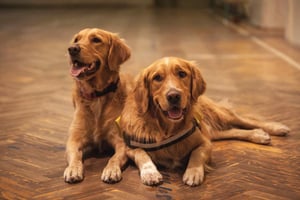Training your dog doesn't have to be expensive. In this guide, we'll cover all the essential tips...
Dog Training for 1 Year Olds: Everything You Need to Know
Training a 1 year old dog can be a daunting task. But, with the right tips and techniques, you can teach your pup the basics and create a strong bond between the two of you. In this article, we’ll discuss the best methods for dog training 1 year old, how to maintain consistency, and how to manage the most common behavioral issues.
Getting Started with Dog Training
Before you begin training your 1 year old dog, it’s important to understand the basics of dog training. First and foremost, you’ll need to establish yourself as the pack leader. This means that you should be the one giving commands and setting boundaries.
Next, it’s important to use positive reinforcement. This means that you should reward your pup with treats or praise when they do something right. It’s important to avoid punishing your pup for making mistakes, as this can lead to negative associations and make it harder for them to learn.
Finally, you’ll need to stay consistent. This means that you should give commands in the same way each time and reward your pup for the same behaviors. This will help them to understand what you want them to do and will ensure that they learn quickly.
Teaching Basic Commands
Once you’ve established yourself as the pack leader and understand the basics of training, you can begin teaching your pup basic commands. Here are some of the most important commands you should teach your 1 year old dog:
- Sit: This is one of the most basic commands and is a great place to start. You can use treats to motivate your pup and reward them when they do it correctly.
- Stay: This command can be a bit more challenging, but is still important for teaching your pup how to obey. Use treats and praise to reward your pup when they stay in place.
- Come: This is an essential command for keeping your pup safe. Use treats and verbal praise to reward your pup when they come to you.
- Down: This command can help you keep your pup from jumping on people or furniture. Use treats and verbal praise to reward your pup when they obey.
- Leave it: This command can help you keep your pup from chewing on things they shouldn’t. Use treats and verbal praise to reward your pup when they obey.
Once your pup has mastered these basic commands, you can begin teaching them more advanced commands like “heel” and “fetch.”
Managing Common Behavioral Issues
Even the best-trained 1 year old dog can have behavioral issues from time to time. Here are some tips for managing the most common issues:
- Jumping: If your pup is jumping on people or furniture, you should use the “down” command and reward them when they obey. You can also redirect their attention by giving them a toy or treat.
- Barking: If your pup is barking excessively, you should use the “quiet” command and reward them when they obey. You can also redirect their attention by giving them a toy or treat.
- Chewing: If your pup is chewing on things they shouldn’t, you should use the “leave it” command and reward them when they obey. You can also redirect their attention by giving them a toy or treat.
- Digging: If your pup is digging, you should use the “stop” command and reward them when they obey. You can also redirect their attention by giving them a toy or treat.
It’s important to remember that managing behavioral issues is all about consistency. You should be consistent in your commands and rewards and should never give up. With enough patience and practice, you can teach your 1 year old dog the basics and manage any behavioral issues.
Conclusion
Training a 1 year old dog can be a challenging but rewarding experience. It’s important to establish yourself as the pack leader, use positive reinforcement, and stay consistent. You should also focus on teaching basic commands and managing any behavioral issues. With enough patience and practice, you can create a strong bond with your pup and teach them the basics.



